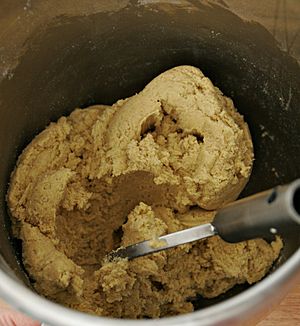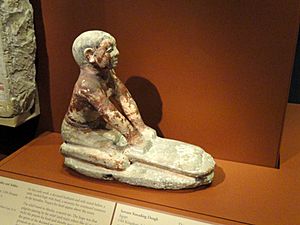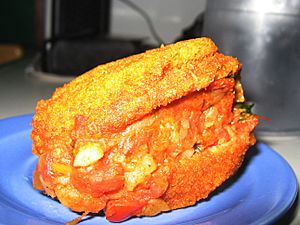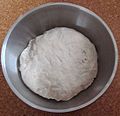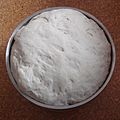Dough facts for kids
Dough is a soft, thick mixture made mostly from flour and a little bit of water. You can use dough to make many yummy foods like bread, pastries, cookies, and muffins.
In central India, people quickly make a roasted dough ball called baati. Flat, unleavened breads like roti, lavash, and tortilla are eaten all over the world.
Dough that uses yeast to rise is called leavened dough. It's made from ground grains mixed with water and yeast. This type of dough is used for all kinds of breads, including those made from wheat, maize, and rice.
Many cultures enjoy fried dough foods. In the United States, a popular fried dough treat is sometimes called "elephant ears."
Contents
What is Dough?
Doughs can be very different! Their differences depend on what ingredients are used and what food you want to make. They also vary by the type of leavening agent (like yeast or baking powder) and how they are mixed. Some doughs are mixed quickly, while others are kneaded and left to rise.
Leavened Doughs
Leavened doughs are usually made from ground grains or beans, mixed with water and yeast. These doughs are used worldwide to make many kinds of breads. Common ingredients in bread dough include salt, oils or fats, sugar or honey. Sometimes, milk or eggs are added too.
Unleavened Doughs
Flatbreads like pita, lavash, naan, roti, and tortilla are eaten globally. Some flatbreads, like naan, use yeast to rise. Others, like matzo, do not use any leavening agents. Crackers are also made from dough, and some, like saltine crackers, are leavened.
Pasta and noodles are usually made from unleavened doughs. This dough is worked until it's smooth and dry. Then, it's shaped into its final form. You can cook pasta right away or dry it to store for later.
Doughs with more fat, like those for many cookies and pie crusts, have less water. This makes them less stretchy than bread doughs. Bakers often call these "short" doughs, like shortcrust pastry.
In central India, people make a quick roasted dough ball called baati. In parts of Africa, dough balls called aiysh or biya are made from sorghum or millet. These are ground and then boiled.
Quick Breads
Quick breads use leavening agents other than yeast. These include baking powder or baking soda. Most cookies, cakes, biscuits, and muffins are quick breads. They can be made from a thick liquid batter or a dough.
How Dough is Made
The way dough is made depends on the type of dough and what food you want to create.
For Yeast Doughs
For doughs that use yeast, like most breads, a common way to make them is to mix the dough, then knead it. Kneading means working the dough to make it smooth and stretchy. This helps develop something called gluten, which gives bread its texture. After kneading, the dough is left to rise. This rising process is called proofing.
Many bread doughs are kneaded again after the first rise. Then, they are shaped into their final form and left to rise one last time before baking. The temperature and time are important for yeast to work well. If it's too hot or too cold, the yeast won't develop. If the rising time is too short or too long, it can affect the final product.
For Pasta and Flatbreads
Pasta is usually made from a dry dough that is kneaded and shaped. This can be done by pushing it through a machine (extrusion), rolling it out with a pasta machine, or shaping it by hand. Pasta can be cooked right after it's made, or it can be dried to last longer on the shelf.
Doughs for biscuits and many flatbreads that don't use yeast are usually just mixed. They are not kneaded or left to rise. These doughs are shaped and cooked right after mixing.
Cooking Dough
While many foods made from dough are baked in an oven, some are cooked over direct heat. For example, tortillas are often cooked right on a griddle. Fried dough foods are also popular in many cultures.
Some foods, like Pancakes, waffles, and many cakes, are made with a semi-liquid batter. This batter is poured into its final shape instead of being a solid dough. Unlike bread dough, these batters don't rely on gluten to hold their shape.
Images for kids
-
Yeast bread dough after rising (proofing), for 40 minutes.
See also
 In Spanish: Masa (alimento) para niños
In Spanish: Masa (alimento) para niños


